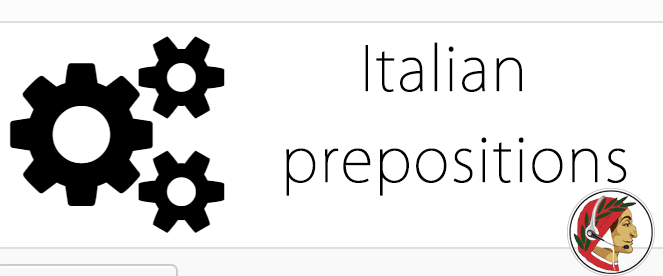Italian prepositions are challenging. Hopefully, some simple examples will help you
Prepositions VS Conjunctions
Italian simple prepositions are eight, usually taught in the following order :
DI – A- DA- IN- CON -SU -PER -TRA/FRA
The role of prepositions in a sentence is to introduce some information attached to a verb or a noun, and explain their function, in the form of a “complemento”. Complements “complete” the sense of a sentence, so changing a simple preposition can change the meaning of a phrase. For example:
- Ho appena parlato di Mario. I’ve just talked about Mario.
- Ho appena parlato con Mario. I’ve just talked to Mario.
The first is a “complemento di argomento”, so the Mario was the topic of the conversation. The second is a “complemento di compagnia”, because I shared the action (parlare) with Mario.
Today’s lesson is not about complementi, however, we will use them to explain the different functions of every single preposition. Read and listen to the examples. Solve the quiz at he bottom of this page.
Preposizioni, Italian prepositions: a nearly complete guide.
This is a “freemium” Italian language blog and quiz
Please log in or subscribe for free.
Subscribe
- Access to our freemium content
- Get new lessons in your inbox
- Get quiz results and score by email
- One free lesson on Skype or Zoom with a native teacher



Great article! I still am a little confused on when to use di vs su for a topic. Clearly you use di for parlare. But when the topic is a book, article, course, etc., I sometimes see di and other times su and haven’t discovered the pattern. Are there any guidelines on this?
Thanks
DI e SU supportano entrambe il complemento di argomento.
Esistono usi consolidati (patterns) che preferiscono DI a SU e viceversa.
Molto spesso dipende dal verbo, legato dalla consuetudine a “di”. Parlare / Discutere. + di + qualcosa.
Ho letto un libro su Garibaldi. Nel caso dei libri, “di” introduce l’autore, non l’argomento, quindi usiamo “su”.
L’esperienza ti aiuterà a usare la preposizione corretta. Ciao.
the examples were very useful and helped me further understand the concepts.
Grazie.
Grazie Riccardo. Il tuo blog e’ molto utile
Prego. Ciao.
Grazie, RIccardo per aver spieghato le preposizioni. Non e’ un argomanto diretto per me.
Prego.
Mi piace questo. Gli spiegazioni sono chiari. E’ molto utile.
Prego.
Riccardo, can you explain to me one doubt:
Why there is ‘piatti in ceramica’ but ‘bicchieri di cristallo’?
They are interchangeable. “in” is more common when we describe commercial items.
Thanks Ricardo, it’s exactly what I was looking for! (long way to go for myself)
Madonna ! tante cose da ricordare!! Non ci riuscirò mai!!
Sii ottimista. Ciao.
Bello, Riccardo! Grazie mille!
Sto sequendo un corso d’italiano qui a New York addesso. Sarò in contatto ancora più tardi, se vada bene per te.
Saluti, Bonita
Ciao Bonita. Puoi ricominciare con le nostre lezioni quando vuoi! Buona giornata.